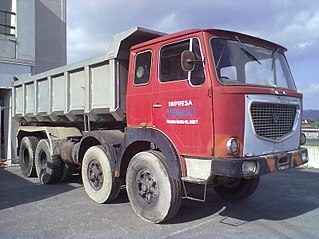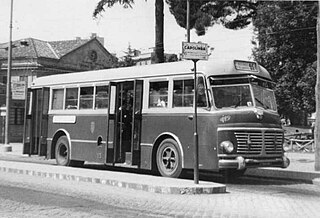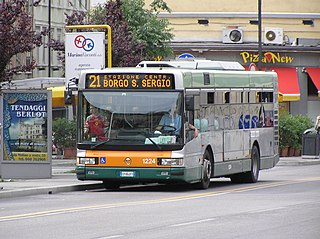Related Research Articles

Italy has a well developed transport infrastructure. The Italian rail network is extensive, especially in the north, and it includes a high-speed rail network that joins the major cities of Italy from Naples through northern cities such as Milan and Turin. The Florence–Rome high-speed railway was the first high-speed line opened in Europe when more than half of it opened in 1977. Italy has 2,507 people and 12.46 km2 per kilometer of rail track, giving Italy the world's 13th largest rail network. The Italian rail network is operated by state-owned Ferrovie dello Stato, while the rail tracks and infrastructure are managed by Rete Ferroviaria Italiana.
Iveco S.p.A., an acronym for Industrial Vehicles Corporation, is an Italian multinational transport vehicle manufacturing company with headquarters in Turin, Italy. It designs and builds light, medium, and heavy commercial vehicles. The name IVECO first appeared in 1975 after a merger of Italian, French, and German brands. Its production plants are in Europe, China, Russia, Australia and Latin America and it has about 5,000 sales and service outlets in over 160 countries. The worldwide output of the company amounts to around 150,000 commercial vehicles with a turnover of about €10 billion.

Lancia is an Italian car manufacturer and a subsidiary of FCA Italy S.p.A., which is currently a Stellantis division. The present legal entity of Lancia was formed in January 2007 when its corporate parent reorganised its businesses, but its history is traced back to Lancia & C., a manufacturing concern founded in 1906 in Torino by Vincenzo Lancia (1881–1937) and Claudio Fogolin. It became part of Fiat in 1969.

Gruppo Bertone, commonly known as Bertone, was an Italian industrial design company which specialized in car styling, coachbuilding and manufacturing. It formerly was also a car manufacturing company. Bertone styled cars for Abarth, Alfa Romeo, Aston Martin, BMW, Citroën, Ferrari, FIAT, Iso, Lancia, Lamborghini, Mercedes-Benz, Opel, and Volvo, among others. In addition, the Bertone studio was responsible for two of the later designs of the Lambretta motorscooter.

The Lancia Thema is an executive car produced by the Italian automaker Lancia between 1984 and 1994, and one of four cars to share the Type Four platform alongside the Alfa Romeo 164, Fiat Croma and Saab 9000. The Thema was first shown in Turin Motor Show in 1984.

Turin Airport, also known as Turin-Caselle Airport, is an international airport located at Caselle Torinese, 16 km (9.9 mi) north-northwest of the city of Turin, in the Metropolitan City of Turin, Piedmont region, Northern Italy. It is also named Sandro Pertini Airport, after former Italian President Sandro Pertini.

The Lancia Appia is a passenger car introduced in 1953 by Italian car manufacturer Lancia as a replacement for the Ardea, and which remained in production for ten years. The Appia was the last in a long line of Lancia production cars dating back to the Lancia Lambda to use sliding pillar front suspension. All three series produced had a 1089cc Lancia V4 engine.

Carrozzeria Boneschi S.r.L. is an Italian coachbuilder, mainly of commercial vehicles. Until 1960, the company was mostly involved with automobile manufacturers such as Talbot, Rolls-Royce, Alfa Romeo, Lancia and Fiat. It was established in Milan by Giovanni Boneschi, moving to Cambiago in (1933). The factory was rebuilt after World War II (1946), after which Boneschi died. Among its designers and directors in the later years was Dr. Bruno Pezzaglia. Boneschi brand has recently been acquired by the coachbuilder Savio.
The Lancia Ro, Lancia Ro-Ro and Lancia 3Ro were 4x2 heavy trucks built by Italian manufacturer Lancia from the 1930s through the 1940s for military and civilian use. The 2-cylinder diesel Ro was produced from 1933 to 1939, the 3-cylinder diesel Ro-Ro from 1935 to 1939 and the improved 5-cylinder diesel 3Ro from 1938 to 1947.
De Simon Group S.p.A. is a bus manufacturer and coachbuilder based in Osoppo, Udine, Italy.

Lancia Esagamma is a truck and bus chassis produced by Italian car manufacturer Lancia from 1962 to 1973.

The Lancia Superjolly is a light commercial vehicle produced by the Italian manufacturer Lancia. The truck, which shares its 815.000 engine and some other mechanicals with the Lancia Flavia, is the successor of the Appia-based Lancia Jolly. The 1½ ton Superjolly has a longer wheelbase than its predecessor. The little truck was produced from 1963 to 1970 in Turin, Italy. The first model (315.000) was produced in 1674 examples, while 1272 of the 1.8-litre 315.024 model meant that overall production was 2948. The Superjolly has front-wheel drive with independent suspension, meaning that the loading area is uncommonly low. The subframe and drivetrain of the Flavia were used, with some modifications to handle heavier work, but the Superjolly also utilized parts from the Appia, Fulvia, and Flaminia ranges. A three-speed manual transmission was standard, although later models had the Flavia's fully synchronized four-speed.

Lancia Esatau is a series of truck and bus chassis produced by Italian manufacturer Lancia Industrial Vehicles from 1947 to 1973. 13,362 examples were produced.

The Lancia Ro is a bus produced from 1952 to 1955.

The Lancia Jota is a series of truck and bus chassis produced by Lancia between 1915 and 1935. The original 1915 Jota was the first true Lancia truck; throughout the following two decades it was made in a number of different series and variants, each identified by a progressive Greek numeral prefix added to the name, from Djota to the last Eptajota. While axle tracks, wheelbase and equipment gradually grew, the original layout and 4,940 cc four-cylinder petrol engine were retained.

Palazzo Lancia, also known as Grattacielo Lancia, is a high-rise building located in the northern Italian city of Turin. It was originally commissioned by Gianni Lancia, president and son of the founder of Italian automobile manufacturer Lancia, to serve as main headquarters for the company.
The Lancia 1Z was a light military truck produced by Italian manufacturer Lancia between 1912 and 1916. From a mechanical standpoint, it was closely related to the 1913 35 HP Theta passenger car. It was Lancia's first military vehicle.

The Fiat 666 was a heavy truck produced by the Italian Fiat Veicoli Industriali.

The Iveco CityClass is an urban, suburban and peri-urban bus launched by the Iveco bus division in 1997 and renamed Irisbus in 2000. It is the equivalent of Agora in France. It succeeds the Iveco 490 TurboCity UR Green urban bus, later replaced by the Irisbus Citelis.
References
- ↑ "Lancia nerenin, hangi ülkenin arabası". Haber Müdürü (in Turkish). Retrieved 2024-02-27.
- ↑ Stampa, Ufficio (2022-05-23). "Lancia trucks: the history of Lancia Trucks". SMET. Retrieved 2024-02-27.
- ↑ "Numero 7 - Luglio/Agosto 2021". Camion&Bus Storici (in Italian). Retrieved 2024-02-27.